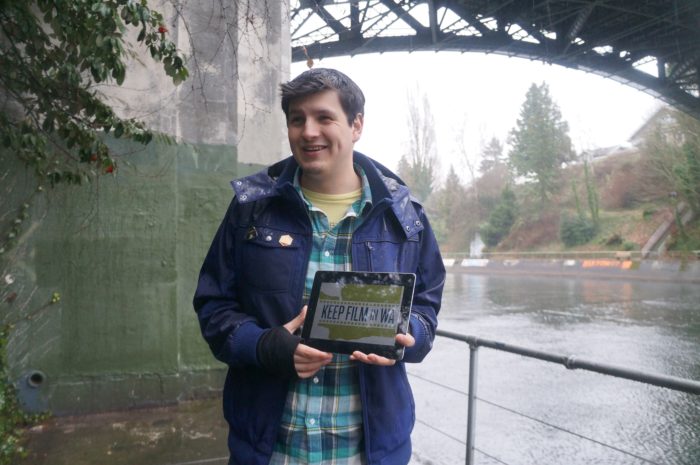
Vancouver has served as an on-screen stand in for Seattle in blockbusters like the “Twilight” Saga, “Fifty Shades of Grey,” and the breakout Chinese romcom “Finding Mr. Right.”
So why is it that so many productions that want to depict the Emerald City end up across the border in British Columbia?
For most productions, it comes down to the film incentive program.
Vancouver’s incentive program is “bottomless,” which essentially means that production companies who apply to film their projects there can get a certain percent of their production costs reimbursed, with no limit on the funds. As a result, Vancouver’s film industry is massive.
Meanwhile, Washington’s similar program is capped at $3.5 million dollars each year. Even that small incentive is due to expire this year, and many local industry professionals are nervous.
“If we don’t get this passed next year we won’t have an industry.”
“The only reason why we have big projects here is because of that incentive program,” Kendra Sherrill, assistant director for the Spokane International Film Festival, said. “If we don’t get this passed next year we won’t have an industry, we don’t have jobs.”
Washington’s film incentive was originally established in 2007 and has since funded 118 projects in the state, according to Amy Lillard, executive director for Washington Filmworks. At the time it was established, around 10 other U.S cities had incentives in place. Now, there are over 30 nationwide.
But this isn’t the first time the state has lost its film incentive program. Kirk Nordenstrom, director of the 48 Hour Film Festival in Seattle, noted that the state’s industry lost a lot of its film professionals in 2011 when the incentives briefly expired.
“We lost a lot of good people that year to LA and Portland,” Nordenstrom said.
Maintaining a thriving, dynamic film industry in the state when other states and other foreign cities are fighting to attract major projects is not a small task. Many other state’s incentives are much higher. California’s is capped at $330 million dollars annually — that’s almost one hundred times the Washington budget. Even Oregon, which offers many of the same scenic backdrops as Washington, has an incentive of $14 million.
“We do a lot with a little,” Lillard said. “I’d like the program renewed so that we can continue to do the work.”
Currently there are two bills in the state legislature to maintain the incentive, Senate Bill 5502 and its companion, House Bill 1527. Only one needs to pass to keep the incentive program in place, but if they both fail, the incentive program is done for and funding will be gone by June.
Neither have made it out of committee so far this legislative session, and many industry professionals are worried.
It’s been a struggle for the grassroots advocacy campaign for the film industry, “Keep Film in WA,” to convince legislators to keep funding the incentive with so many other major budget items like mental health and education competing for the same cash.

“We’re hoping to get them to see it not as expensive but as an investment — it comes back,” Juan Mas, a Washington Filmworks board member and episodic director for the SyFy series Z Nation, said.
Advocates of the bill point to the fact that the incentive doesn’t just help the film industry, there are a lot of indirect financial benefits for other industries in the state. Production companies hire Washington catering staffs, go to Washington restaurants and rent out Washington hotel rooms while filming.
According to Keep Film in WA, with every dollar paid to a production company by the state, the companies spend $4 on feeding and housing crews, purchasing props and buying other production supplies within the state.
“The film incentive program essentially pays for itself,” Nordenstrom said. “It’s like feeding and housing an army.”
That’s not to mention residual tourism from iconic films that spotlight the region: “Sleepless in Seattle” still attracts tourists to the famous Lake Union house boats in the 1993 film, and the sleepy Olympic Peninsula town of Forks got a big boost from “Twilight tourism.”
But while the movement sounds like a no-brainer to many — incentivizing film production companies to shoot in Washington and hire local crews — some in the industry agree that now might not be the time for such a passionate push for funding.
Robert Bojorquez is a self-proclaimed detractor to the movement and has been pushing against its tactics recently.
“There are other bigger budgetary issues going on in Washington state right now,” Bojorquez said.

Bojorquez says he is generally supportive of the incentive program, but he wonders whether now is the right time to be focusing on film above other pressing budgetary matters. He argues that it feels odd to press legislators to fight for funds for the film industry when major issues like education are starved of funding. To Bojorquez, the focus should be put on helping Washington’s youth, which could ultimately help usher in new filmmakers to the state’s industry.
Juan Mas thinks all of these issues ultimately tie together.
“We’re also talking about an industry that is constantly creating educational possibilities,” Mas said.
Mas noted that the incentive applies to the broader medium of digital production, not just major motion pictures. The incentive program affords for work in film and television but also web series and even virtual reality.
At this year’s Film Day on Monday, March 13, industry professionals are gathering in Olympia to meet with legislators, and Filmworks will have a display of virtual reality content made by Washington creators. Their hope is that lawmakers will see the benefit of the state becoming a more competitive part of the film industry at large. But with the bills stuck in committee, perhaps not getting a vote at all this year, the future of the incentive program is in doubt.
“What’s so wonderful about Washington state is that we have every possible terrain. You can film every story here within a couple mile radius,” Sherrill said. “You’ve got to establish that we’re a great place to make film, and then we’ll start getting bigger projects.”

